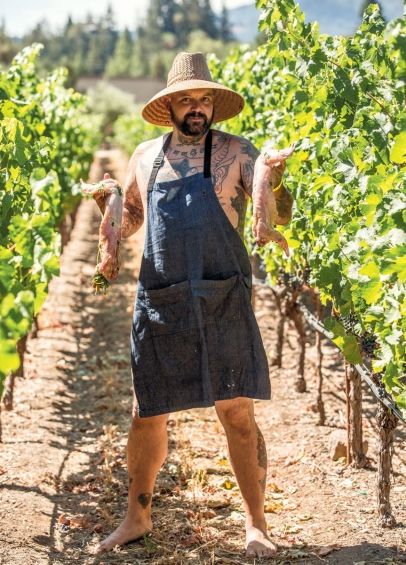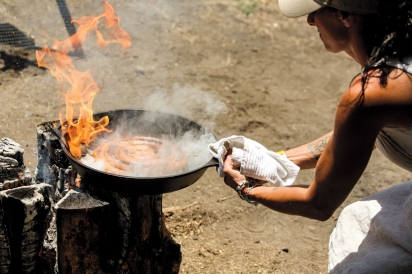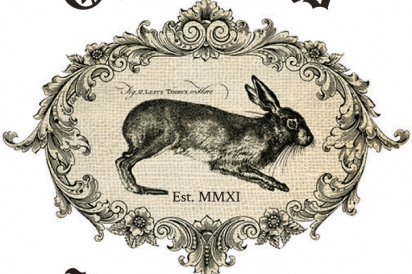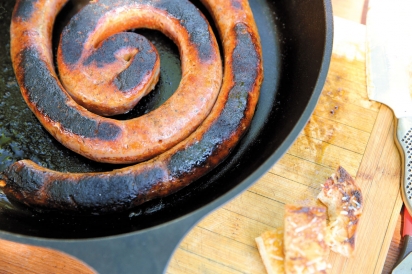Old World Rabbitry's Eric Shevchenko
A Revolutionary on a Hare-Raising Mission
Traditional farming is surrounded by folkloric superstitions, codified or otherwise. And the myths and lore that surround rabbit farming are especially ancient and numerous. From when in the moon cycle to slaughter rabbits for the best-tasting meat to the origins of rabbit’s feet as talismans, third-generation farmer Eric Shevchenko, owner of Sebastopol’s Old World Rabbitry, has seen and heard them all.
Raised in Michigan, Shevchenko learned about farming from his Ukrainian grandfather. Dedushka Shevchenko raised rabbits for food and taught his grandson the best diet to feed rabbits for the best-tasting meat and how to properly clean and age rabbit meat the old-fashioned way, without the benefit of a freezer or refrigerator. His love and care for the animals in his charge and passion for growing and eating other fresh, mostly homegrown foods, were passed down to Eric, who grew up with a love for animals of all kinds.
That love, and a wandering spirit, has taken Shevchenko all over the United States. He worked a summer in the late 1990s at the Wild Spirit Wolf Sanctuary near Gallup, New Mexico. He trained dogs for the Iditarod and Yukon Quest dog races in Michigan’s Upper Peninsula. He’s worked in many dog kennels and even spent time working at a zoo.
Before and after, and in between, for nearly 20 years, Shevchenko also worked in natural foods stores around the country.
It was in 2005 that Shevchenko returned to his farming roots, launching a short-term, trial chicken farm set in the woods near Athens, Ohio, soon after his daughter, Zoya, was born.
But the West beckoned, and a few years later Shevchenko found himself raising rabbits on a small ranch in Napa. Fate was not with him, however: Two short years after launching the venture, the majority of his 200 rabbits succumbed to myxomatosis, a viral disease spread by direct contact with other infected animals or by mosquitos, and he had to close the ranch.
Undeterred, Shevchenko initially relocated his operation to Forestville in Sonoma Country before landing at Old World Rabbitry’s current home in Sebastopol. In his new location just seven months at the time of this writing, Shevchenko has rebuilt his farm, step by laborious step. Known for the speed at which they reproduce (gestation is normally 28 to 32 days) and for their large litters (one doe (female) can deliver up to 13 kits at each birth), rabbits bred for meat at Old World Rabbitry come from a mix of the most popular breeds. Originally from France, Giant Chinchillas are also known as the Million Dollar Rabbit for their heritage value in the fur market. Blanc de Hotot rabbits, also from France, have lovely pink meat. Flemish Giants (from Belgium) have bigger bones than other breeds and are often used in breeding to develop bigger rabbits. California Whites, a cross of a Himalayan breed and a standard Chinchilla, originated in the southern part of the state while the origins of the New Zealand White rabbit are unknown.
No matter their heritage, rabbits are particular creatures known to be personable when their routines are undisturbed. “Rabbits are very sensitive,” Shevchenko says, “especially during birth. If a mouse runs through the barn at that time, they may ignore or even eat their babies.” They can be fastidious at all stages of life.
At Old World Rabbitry, kits stay with their mother for four weeks before they are moved to what’s known as a grow-out pen. Sexual maturity for males (bucks) occurs as early as 3 months of age (does mature at around 5 months old) and the young rabbits, like many teenagers, need their space.
“Bunnies are dominant and territorial,” says Shevchenko. “They do well until maturity, but then they can get aggressive. Left to their own devices, out in a field, rabbits are mean,” he says. “They will rip each other up.”
Shevchenko says the experience with myxomatosis taught him and his business and life partner, chef Tiff any Friedman, that the natural, traditional ways of raising animals for food were best. Hearkening back to his childhood, Shevchenko recently launched a program of nutritional farming in which naturally foraged and seasonal plants, sourced mostly from the ranch itself, are fed to his animals. In the greenhouse, Shevchenko raises high-protein wheat grass then mixes it with vitamins and minerals including potassium, calcium and vitamins B1 and C. Barley and sunflower are grown to feed to the rabbits as sprouts. Burdock and root vegetables occupy the remainder of available greenhouse space.
The ample ranch yard is fenced, but the rabbits are mostly unable to spend time there because of the aforementioned negative personality characteristics. “If left to their own devices, it would turn into Watership Down out there,” Shevchenko says, referencing the seminal 1972 work by Richard Adams of the difficult, sometimes brutal, life of wild rabbits.
The hay yard on the ranch is put to good use in other ways. The grasses are dried and used for rabbit food as well as for bedding and nests. And, lucky rabbits, the yard provides treats of seasonal, locally foraged fruits, including persimmons. The rabbits also eat alfalfa pellets and non-GMO raw alfalfa sourced from off the ranch.
Similar care is taken with the chickens in Old World Rabbitry’s burgeoning poussin (a “spring chicken” or chicken slaughtered at 25 to 28 days old) program. Their diet, mostly grasses and legumes, is 100% lacto-fermented with Sonoma buffalo milk whey, which increases the bioavailability of the nutrients in their food. The birds are finished for a minimum of 14 days with high-fat flax meal. “Our continued goal is working towards healthier fats in the diet of the birds which, in turn, translates to a cleaner product for our customer,” says Friedman.
The results of the change in diet to a locally sourced (almost 50% of the rabbits’ and the chickens’ diet comes directly from the ranch) are dramatic. “What you feed them changes everything,” says Shevchenko. “Before I changed their diet, the rabbits’ livers were this unhealthy purple color. They weren’t flushing properly.” The livers are now a beautiful, deep burgundy color.
Shevchenko works with a slaughter facility in Fairfield to properly calm the rabbits before they meet their final fate, minimizing the animals’ stress and the impact of slaughter on the taste of the meat. This, along with the new diet, helps ensure the meat arrives at a chef ‘s doorstep with the proper level of acidity. “You can look at the meat and know it is the right level,” says Shevchenko, whose high-quality meats are known in certain foodcentric circles for their proper texture and rich flavor.
“I met Eric five years ago, when he was just starting the business,” says Joshua Schwartz, chef de cuisine of Napa’s Del Dotto Winery. “We are both old school and Eric takes a lot of care in how he raises his animals. It caught my attention.” Schwartz, who loves to prepare a Campanian-style rabbit stew with tomatoes, peppers and onions, counts myriad other ways to prepare rabbit. “I’ve wrapped the loins in bacon and potato, served the ribs in a rack like you do with lamb, seared and confited the legs and turned them into rillettes. And I love the liver; it is great to sauté or turn into mousse or pâté.”
Schwartz also brings in the poussin, working closely with Shevchenko to coordinate his menu in tune with the birds’ growth and harvest schedule to ensure the freshest product on his guests’ dinner plate. “As a chef, I strive for relationships with farmers that raise animals right. Eric has brought something that was missing out here.”
Similar praise is heaped on Shevchenko by Healdsburg SHED’s new culinary director, Perry Hoff man, who currently purchases only the poussin but plans to start using rabbit soon. “Honestly, before we received the poussin, we were planning to brine the birds. Then we got one in and roasted it off. The meat was incredibly flavorful, rich and succulent. We decided that we should do almost nothing to it, that the bird was perfect as it was.” Hoffman has the poussin on his current menu served whole, including the head and feet, accompanied by wilted kale, roasted turnips, radishes and wild mustard.
“I smile every time I serve it,” says Hoffman. “It is people like Eric and his passion for raising poussin and rabbits like these that really make this chef internally happy.”
More chefs in wine country and around the country are also taking notice. Chef Michael Tusk of Quince and Chef David Barzelay of Lazy Bear, both in San Francisco, recently began working with Old World Rabbitry’s rabbits and poussin. Chef Scott Eastman of Corso in Berkeley purchases hundreds of poussin every month. Long-standing relationships have developed between the ranch and Chef Jose Andres of the Jose Andres Think Food Group, Dominquez Crenn at Atelier Crenn in San Francisco and Chef Thomas Keller of The French Laundry.
Chefs and their diners may be the final arbiters in how well Old World Rabbitry husbands its animals, but the care and love that Shevchenko feels for his animals is evident in every aspect of his business and his person. He opines passionately about proper housing, feed, slaughter and other aspects of animal management. His mission to raise and slaughter animals as humanely as possible is deeply ingrained.Outside the world of farmers and chefs, Shevchenko may appear to be an iconoclast, but if you look deeper he is a revolutionary with a mission. Shevchenko states his intentions clearly and without bluster, going so far as to ink his body with images of animals. His brother, Chad Koeplinger, a tattoo artist, created most of the images, among them a rabbit on one upper arm and the words “dire wolf “ (a now extinct North and South American large mammal of the Pleistocene era) inscribed onto his fingers. This is a man for whom the care of animals is deeply rooted, inhabiting not only his skin and blood, but his soul.







